 This Sunday (10/10/10) Beam Reach will be joining thousands of other 350.org activists around the globe to do something about global warming. If you’d like to help reduce the concentration of carbon dioxide in the atmosphere from its current level, 390 parts per million (ppm), back down to what scientists say is a safe limit (350 ppm), then use this map to find a local event that interests you.
This Sunday (10/10/10) Beam Reach will be joining thousands of other 350.org activists around the globe to do something about global warming. If you’d like to help reduce the concentration of carbon dioxide in the atmosphere from its current level, 390 parts per million (ppm), back down to what scientists say is a safe limit (350 ppm), then use this map to find a local event that interests you.
If you can’t find an inspiring action to join this weekend, we recommend that you use this cool website to make your home more efficient. Not only does the site provide a prioritized list of actions you can take to reduce your carbon footprint, but also it shows you how you can save money through conservation. It turns out green is gold!
We who live in Washington State have a special obligation to reduce our energy use. Not only do many of us contribute to global warming by burning natural gas or fuel oil to get through the cold months, but our electricity use is directly impacting the hunger level of one of our most cherished regional icons: the killer whale. You might think that because Washington Public Utility Districts get 82% of our electricity from hydropower, that we’re pioneers of sustainable energy use in America.
The problem is that we’ve recently learned that our local orcas love eating chinook salmon, particularly the big fish that return to the Columbia and Fraser Rivers. Unfortunately, the same dams that provide our power are preventing the recovery of chinook populations on the Columbia and Snake Rivers. Reducing our energy use in Washington is a direct way to allow more water to be spilled over dams in the short term (increasing smolt survival) and more dams to be removed in the long term (giving adult salmon easier access to pristine habitat). With plenty of salmon to power them through the winter, perhaps our orcas could recover from their current ~85 animals to their historic 150, bringing the combined (southern and northern) resident killer whale population to 350 itself!
On land at Beam Reach headquarters in Seattle, we’re always humbled when the students at sea report their water and energy use levels. Their typical daily water usage is only 2.5 gallons/person/day! In comparison, in our typical residential house we use 40 gallons/person/day.  All energy on the Beam Reach boat comes from biodiesel, and the students’ usage is about 0.5 gallons/person/day.
At sea, we’ll be continuing our efforts to practice sustainability science. We’ll be powering our studies of endangered killer whales with biodiesel bought from local supplier Island Petroleum Services.  Our captain, Todd Shuster, encourages us to burn biodiesel instead of fossil diesel in the 42′ sailing catamaran, Gato Verde, that has a nearly-silent Prius-like hybrid electric propulsion system that enables us to listen to the orcas as we move with them. We’ll also be discussing the science and ethics of deriving liquid fuels from oceanic plants while filtering some plankton and taking a first stab at extracting their oil for conversion to biodiesel.
If you’re not a home owner or can’t modify your living space, another action we recommend is to try cooking a meat-free meal this Sunday. Food production from farm to fork is responsible for between 20-30 percent of global green house gas emissions. Over your vegetarian meal you can discuss joining the meat-free Mondays movement, a way to make small changes in your life that can make a big difference for the planet.
There are many ways to lower CO2 levels and many questions yet to answer. We hope you’ll join us in considering them creatively while taking a few practical steps forward this weekend.
Read More
Have you ever come so close to your goal that you can literally see it breaching out of the water in front of you, only to have it slip away? Or perhaps you recall the tale of sysaphus, pushing his boulder up the hill only to have it roll back down again just when he got to the top. Or maybe your team had the other pinned deep in their own territory, 4th down and 26 with less than a minute to go, only to watch that victory slip away? Well, not to be too dramatic, but that’s how close we were to seeing some Orcinus orca the last two days but not quite getting there. First we weighed anchor on Friday with the knowledge that fall was really upon us: K-pod was heading down admiralty inlet towards Seattle in search of the fall chinook and chum runs. Off we went, though it would prove to be a five hour trip down there. Admittedly, some of us were secretly pleased that we wouldn’t be recording data right away, given the 5:00 deadline for our proposals. Maybe we dusted ourselves with a little karma with those thoughts. Suffice to say that we pulled in to Port Townsend sans whale sightings (they were too far down Puget Sound). BUT, when we were playing around with our underwater camera and microphone at 10 at night, well fed and relieved to have turned in our projects, checking out the nudibranchs, nutridiums and nerocystis on the ocean floor, suddenly, an S16 call comes in the speaker. We rush up to the dock, turn on the hydrophone up there, and listen as our quarry passes us in the dark, heading north. ALAS!
In the morning, we are hopeful that somehow there might be a few whales still in the sound, or that they turned around and came back in. Did we come all the way down here just for an evening of cell-phone service and flush toilets? We linger, hopeful. That lingering proved too much. By the time we’re sure that no reports will come in from the sound, after we listened to 45 minutes of live internet broadcasts from Lime Kiln (www.orcasound.net, listen to sample orca calls: S17 (possibly) recorded 9/14/10, S6 (recorded 9/14/10), S1 (recorded 9/16/10), S2 recorded 9/22/10, (1st call in 2 hours, preceded a change in direction), S9 (sample file)), we’re fighting currents in our quest to get back to the islands. Reports are coming in left and right: whales at Hannah Heights! Black and whites at Kellet Bluff! K-pod at turn point! Our usual stomping grounds are silly with whales, but we’re dodging shipping traffic in the straight of Juan de Fuca. Then, just as we’re nearing our potential harbor for the night, we hear reports. They’re just around the corner. They’re heading south (towards us!). We change plans and sail off towards them. We get closer and closer. More reports come in: they’re calling a lot! They’re…heading north! (d’oh!) We’re so close we can see spouts and the occassional breach. But now they’re traveling. And the sun is setting. And we have to head to harbor for the night. We settle our stomachs with some gourmet burritos, settle our academic interests looking at the moons of jupiter, and go to bed hopeful for what will be tomorrow.
Oh yeah, and if any of you happen to know (or be) my mother, tell her happy birthday!
Read More
Log for September 16th, 2010. The most bio-diverse day to date in the Beam Reach Experience!
Our days aboard “Gato Verde” (the 42′ state of the art Catamaran that is now our home) have been nothing short of surreal and magical. But on this particular day, the foggy and mysterious 26th day in September, Poseidon was definitely on our side. It’s a foggy and mysterious morning, sailing with caution we set on our course for the day. Captain Shuster blasts his ‘fog horn’ at 5 minute intervals to warn any ‘invisible†vessels of our presence. By 10:30 am we’ve reached the bird aggregations (way point 168), surrounded by hundreds of birds of various species we are suddenly surprised by a couple of Minke Whales (Balaenoptera acutorostrata) foraging in the area. They’re  moving slowly among the kelp, giants among the dwarfed birds that rest on the surface. In the middle of our observations a baby harbor seal (Phoca vitulina) visits the stern of our boat, seemingly wanting to get on board. Val’s sniper ‘s training pays off as he captures an elusive puffin. The exact genus of this fleeting bird confounds the naturalists and scientists aboard the Gato.  The angle of the shot is not ideal, but a puffin it is indeed, that is a fact they can all agree on. Unable to decide between the Horned Puffin (Fratercula corniculata) , or the Tufted Puffin(Fratercula cirrhata), they leave the matter to rest, but a profound discontent lingers in the air. ‘Tis then when a Stellar sea lion (Eumetopias jubatus) is spotted frolicking in the kelp, yet another wonder hiding in the heavy fog that envelopes the bird aggregations. Cat, our young and enthusiastic Britt scientist, is able to record acoustically some of blows from the Minke’s for later comparison, taking advantage of the very quiet conditions we’d been enjoying on this lonely morning. By 1.30 pm we catch up with the orcas (way point 170). The day is still very foggy and there are fewer boats around than usual, including various small research outboards. In spite of the heavy fog, we are able to observe the whales in very active behavior: tail lobs, rolling, “cart wheels†breaches,  porpoising, periscoping, baby tail slapping. Around 2.30 some in the group see a calf spy hopping and vocalizing above water. We then enter a fog patch and think to have lost them, but then, all of a sudden, a crazy display of behaviors and vocalizations almost above water surrounded us. The ambient noise is now very low, and the whales and their echoing melodies are heard and recorded with crystal-like quality. The crew is now in a strange trance, no one can believe our luck. This day was to be recorded as the most exciting and biodiverse day in our adventure to date.
By the late afternoon, as the pretty Thea Foss crosses our path, we catch a school of Dall’s porpoises riding their bow wave. The perfect end to a perfect day.
Thanks for reading.
V
Read More
As we prepare to embark on our second boat tour, I’m reminded of a concept that I first learned about from the Coen brothers but have since discovered for myself. They made a film around the turn of the century loosely based on The Odyssey about a trio of misfit fugitives on a quest to find easy money. For each of them it means a different thing. For one, it’s buying back the family farm, for one it’s the security and self-importance that comes with operating a fine restaurant, and for the Odysseus character, it’s about (of course) winning back his wife from a nefarious suitor but also about finding an occupation and a life path from which he can derive pleasure and satisfaction. The film opens with an original 1928 recording of Harry McClintock performing The Big Rock Candy Mountains, a song about a hobo’s paradise where the jails are made of tin, where they hung the jerk that invented work, where lakes are made of stew and where you never change your socks while you sit beside a whiskey stream, trickling down the rocks.Â
This, then, is the stage we’re at in our time here We had two weeks of more adventure and learning than one could hope to ask for. You can read in other posts about our gallavanting with minke whales, breaching orcas, water so calm and clear that you can see whales underwater as they pass and being pushed around the ocean by the wind’s free energy. Was it real? Did, as I remember, we really spend every day looking and listening to whales, and then using math to understand our findings? (Remember, in my past life I was a math teacher, so applications of trigonometry warm my heart a bit). As we spent the last few days on land catching up with the real world and then working hard with faces in computer screens and headphones on, analyzing our data and putting it in a usable form, the memories have faded a bit. Can this Big-Rock-Candy-Mountain of the sea really exist? Or did we make it up? Wallace Stegner, in a novel he appropriately titled The Big Rock Candy Mountain, has the protagonist “never quite grant that all the good places were filled up. There was somewhere, if you knew where to find it, some place where money could be made like drawing water from a well, some Big Rock Candy Mountain where life was effortless and rich and unrestricted and full of adventure and action, where something could be had for nothing.” That’s what he was searching for. For us these next two weeks, all I can ask for is that same feeling that was described so well on these other posts. That’s my Big Rock Candy Mountain. And I’m so excited to get back on that boat to go searching for it again!
If technology is on my side, I’ll leave you with a video we shot that first week. Just a fleet of porpoises jumping around the boat. That’s all. No big deal, really. Just another day in the Big Rock Candy Mountains. 
Porpoises Porpoising
Read More
Hey everyone,
We are now back on dry land and showered! I couldn’t wait to share our week with you, so here it is.
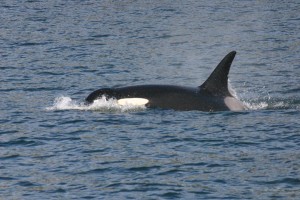
We found the whales on our first day back at sea – we must have a good luck charm on board! The poirpoises also came back with one playing around our boat while Jason went to pick up Val from the beach. It was Vals birthday and he brought cake with him – it was the first thing he made sure was safely on board when he arrived. The weather was the windiest and the sea the choppiest we have had so far so we hoisted the main sail! Which was a hilarious experience in itself – 6 students clinging to the boat while todd explained how to hoist the main sail and val jumping around with ease taking pictures – he really put us to shame! But we soon found our sea legs and took to moving around the boat with ease, sitting on the bow seat and even the trampoline (we got a bit wet!). I don’t think me, Garrett and Hana came in all day! We had wind, wonderful weather (sunshine) and whales what more could we ask for. Even though I must say trying to get good microphone recordings in the wind is hard! In the evening we anchored and got to try Val’s birthday cake and sing to him. We then headed off for walks in the woods and stretched our legs.
Tuesday couldn’t have been more of a contrast to monday – it was glassy out on the water it was so calm. We found the whales early on and were with them all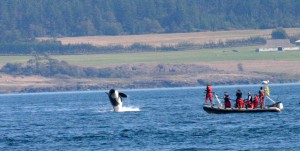 day. We got some good recordings and even saw the NOAA boat tagging one of the whales, unfortunately it looked like it fell off just a short while later. They were doing lots of breaching and spy hopping too today and we saw some great feeding behaviour right next to the shore. Then we all sat down to do some journal reading – see we do do some work on this boat too – its not just fun and games i promise!
day. We got some good recordings and even saw the NOAA boat tagging one of the whales, unfortunately it looked like it fell off just a short while later. They were doing lots of breaching and spy hopping too today and we saw some great feeding behaviour right next to the shore. Then we all sat down to do some journal reading – see we do do some work on this boat too – its not just fun and games i promise!
Wednesday we found the whales at 12pm and were in for a treat! They spent several hours resting and we were able to get several good recordings and then just as if an alarm had gone off they all started socialising and being really active They were breaching (at least 30), spy hopping and doing tail slaps. It was a real treat to watch!
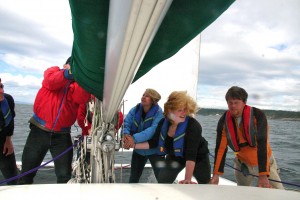 Thursday = FUN FUN FUN! It was the perfect day for sailing. We decided it was too choppy to get recordings so we had a sailing day. It was also a great chance to break out our rain gear. Hana looked like a ninja and Garrett was just a huge orange blob. I hoisted the mainsail and was surprised at my own strength, I think I surprised everyone else too! I didn’t go inside the whole time. The best bit of the day was when me, Megan and Garrett all sat on the edge of the trampoline and were getting splashed by the waves – it was like a rollercoaster. Garrett even sat completely on the trampoline and when we hit a wave he flew (yes actually flew) in the air it was hilarious. Sailing is officially the coolest way to travel.
Thursday = FUN FUN FUN! It was the perfect day for sailing. We decided it was too choppy to get recordings so we had a sailing day. It was also a great chance to break out our rain gear. Hana looked like a ninja and Garrett was just a huge orange blob. I hoisted the mainsail and was surprised at my own strength, I think I surprised everyone else too! I didn’t go inside the whole time. The best bit of the day was when me, Megan and Garrett all sat on the edge of the trampoline and were getting splashed by the waves – it was like a rollercoaster. Garrett even sat completely on the trampoline and when we hit a wave he flew (yes actually flew) in the air it was hilarious. Sailing is officially the coolest way to travel. 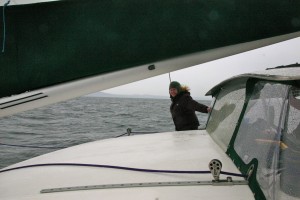 We all had a turn at the Helm too. In the afternoon the winds got up to 30 KT which was the limit we can sail at so we headed back in to anchor. On the way back Captain Todd took the helm and we sat at the bow while the boat surfed on the waves! Very cool! We had a journal club in the afternoon that I hosted and I have to say my article was the most confusing to read yet – sorry guys!
We all had a turn at the Helm too. In the afternoon the winds got up to 30 KT which was the limit we can sail at so we headed back in to anchor. On the way back Captain Todd took the helm and we sat at the bow while the boat surfed on the waves! Very cool! We had a journal club in the afternoon that I hosted and I have to say my article was the most confusing to read yet – sorry guys!
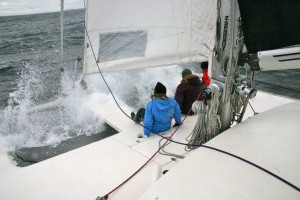
Friday will now be remembered as Disney day! We listened to Disney all morning as we headed north to hopefully meet the whales as they headed south from coal docks. We had a bit of everything but the best was definitely circle of life while we all worked away on our computers! We did find the whales and  even got a chance to talk to the straight watch guys (http://www.straitwatch.org) who were interested in our hydrophones and my microphone. Which on a side note, has lead to me being called the mic made, because i carry it around all day!
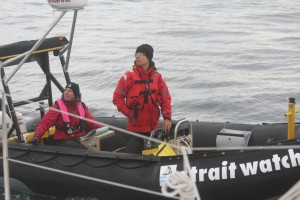
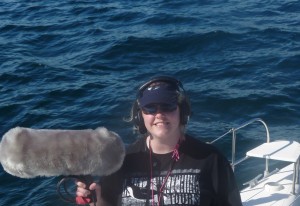
Saturday was the perfect last day on the boat. We had beautiful sunshine – even Hana was only wearing one layer of clothes! We met the whales by lunch time and followed them all day until we had to turn round. On the way to anchor near the friday harbor labs we deployed the dinghy and did a locilisation exercise using underwater speakers and our hydrophones. Megan loved being in the dinghy. In the evening we even got our first chance to play with the critter cam. Its an underwater camera we lights mounted on it. You know your a science geek when you can watch shrimp for several hours and not even realise! We did get to see some crabs and flounders too.
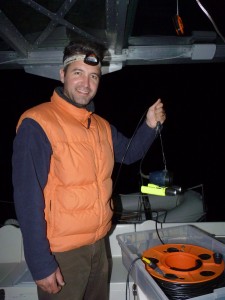
So as you can see we had a great second week at sea, and im sure we will have many more 
Read More
I am going to start this blog by saying that sailing is definitely the ultimate way to get around. Thursday gave me a chance to try out my new orange rain gear (see the pictures), and it worked great. Megan, Cat, and I stayed on the deck for the entire time we were sailing, and we were all a little disappointed when the Captain made the decision to head in due to high winds; in Captain Todd’s defense it was the correct decision to keep us safe, and we appreciate and respect that. Todd also showed how much he trusts us by giving each person a turn at the helm for each type of sailing we encountered. It turns out staying on course is a lot harder while sailing down wind instead of up wind, and I feel like I learn a lot each time I take the wheel. We stayed North at Patos Island that night, and we had the little bay to all to ourselves except for a Harbor Seal that was eating a huge Chinook Salmon next to the boat. I used the time there to ask the Captain about his experiences with sailing, and it led to a very interesting conversation, and it ended with him lending me sailing magazines and recommending some really interesting books.
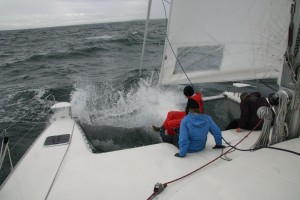
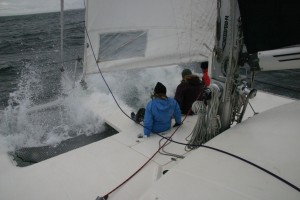
Today is our last day on the boat before our three day break on land to work on our preliminary data products. We are in Parks Bay and Jason just got done showing us the Beam Reach underwater video camera called the Critter Cam. It was great to see everyone hovering around a computer for well over a hour, in the cold night, getting excited over a bunch of shrimp, some crab, and even a few flounders. After tonight I know we will be using the Critter Cam again, and we will definitely post some video and pictures of what we find in the future. Until then I plan on using my legs as much as possible while I am on land, and enjoying the showers while they last.
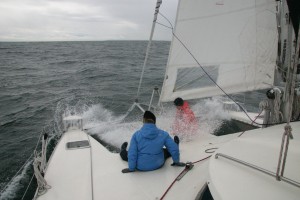
Read More

Friday Harbor afternoon rowing
The last time I visited the fall students up in the San Juans, I was pleasantly surprised to learn that Vanessa is a particularly talented photographer (and that she uses a Canon Rebel XT, the model Beam Reach has adopted as a standard). After discussing the nuances of different camera settings, she kindly contributed some of her favorite photos of her Beam Reach experience to our on-line gallery. Here are a few examples of her ability to artfully capture diverse facets of the Beam Reach adventure. You can see (and rate) all of her shots in the Beam Reach gallery.

Friday Harbor night

Row boat oars at Friday Harbor Labs
I thought things at Beam Reach were awesome last week, but man, they just keep getting better and better! These past few days have been absolutely STUNNING! It’s been clear, sunny, and even a little wild on the water! Monday we had some wild waves, and had our first true chance to test our sea legs. Luckily we all passed the test, and had a blast sitting out on the bow of the Gato Verde, enjoying the sunshine and salty wind on our faces as the boat plowed through the most significant waves we’ve experienced yet! And the best part was that we got to see orcas after riding what felt like a mini roller coaster!
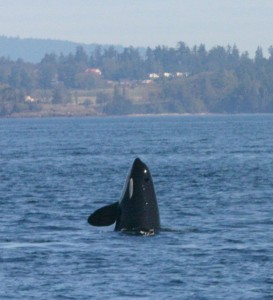
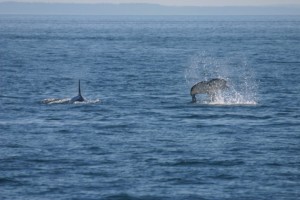
Yesterday and today have been some of the most beautiful days we’ve had out on the water. It’s been bright and sunny and clear, and there have been huge, and I mean huge, amounts of whales gathered together! Today there were at least 40 clustered into 2-3 groups and we saw almost the same yesterday–someone (sorry, not sure which whale watching operator it was) called yesterday one of the best days of the season, and I believe it! The orcas were resting for a good portion of the day, and it was crazy to see them all gathered together, rising and falling in uniform synchronization in such huge numbers. Suddenly, around Turn Point, the whales woke from their resting state, and almost flew down the coast! They would absolutely blast through the water–it was porpoising like I’ve never seen before.
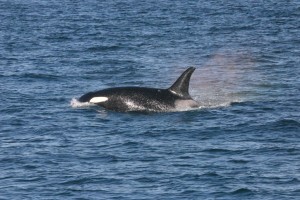 You truly get an idea of their speed and power when they’re in travel mode! We even got to observe foraging behavior, as many of the whales stuck around to feed, making quick lunges, deeper dives, and moving in random, sporadic movements! All the behavior changes were great for me, since part of my research question will be comparing echolocation click rates and behavior states; I got a lot of excellent data to analyze!
You truly get an idea of their speed and power when they’re in travel mode! We even got to observe foraging behavior, as many of the whales stuck around to feed, making quick lunges, deeper dives, and moving in random, sporadic movements! All the behavior changes were great for me, since part of my research question will be comparing echolocation click rates and behavior states; I got a lot of excellent data to analyze!
Today was just a continuation of yesterday’s amazing weather and behavior. I have never (granted, I’m still a newbie at this whale research thing) seen as many whales grouped together as I did today. We heard that members from J, K and L pods were clustered in the super-pod we followed! In addition to huge numbers of whales, they were so active: so many breaches (I saw at least 30!), spyhops, tail slaps, peck slaps, nuzzling…you name the behavior, the whales were doing it! I think they were enjoying the beautiful weather just as much as we were! I was honestly star-struck by the number of whales and gorgeous behaviors we saw today. I was honored to be able to observe their world, and so thankful that Beam Reach has given me this wonderful opportunity to pursue my love of orcas! I’ve said it before, and I’ll say it again (likely every post I make!), these whales are more than gorgeous, they’re more than amazing. They inspire me to do everything in my power to help them, and I’m so glad that this is my life right now. I love every second of this!
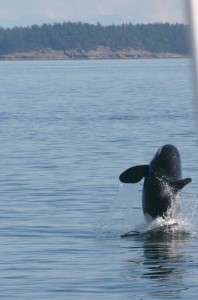
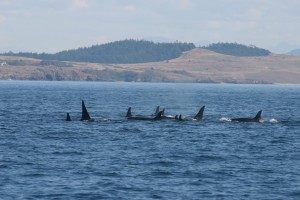
Read More
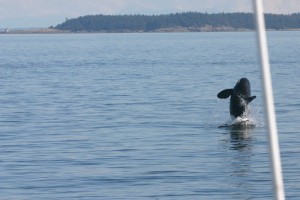
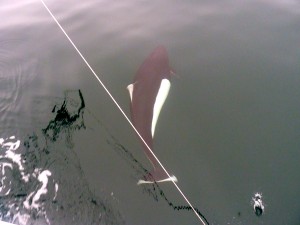
After cleaning and getting everything in order while at Friday Harbor we had the rare chance to sleep in the next morning before taking off again. Once we were back on the water we were lucky enough to finish our day with learning a new form of sailing which involved the screecher sail. aptain Todd is great teacher for sailing, and on Monday we were out on the west coast of San Juan Island clinging to the side of the boat in 20 knot winds learning how to deploy the mainsail and the jib. This was a perfect first day back on the boat, because it had a little bit of everything. We started the day with some amazing sailing in 2-4 foot waves; which didn’t agree with everyone on the boat unfortunately. After sailing for a few hours we found the whales, and the wind died enough to allow for the hydrophones to be deployed. Two sets of high quality recordings were made while we were surrounded by the whales, and the the amount of data we have is slowly getting bigger each day. We ended our night in Prevost Harbor, which gave everyone a chance to take a walk and stretch their legs. On the way to Prevost 5 or 6 Dall’s Porpoises began to bow ride on the boat, and they stayed there long enough for us to get some pictures of them underwater. This day was timed perfectly for the birthday of our professor Val, and on top of everything else that happened we celebrated his birthday with a delicious coffee cake after another great dinner.
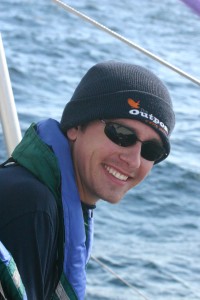
Tuesday brought another great day on the water. The Captain continued our boating education with a lecture on the tides in the Salish Sea. Tides are very important for navigating any type of boat, however the tides throughout the Salish Sea are especially strong, and they can be dangerous if you don’t know what you are doing. After our tide lecture we managed to find the whales again, and we stayed with them for most of the day. At first they were resting, which means they move slowly in a close group, and they don’t produce many sounds for us to record. This changed by the end of the day when the whales woke up from their nap, and we had a front row seat to watch them breaching, spyhopping, and socializing in general. Seeing the whales foraging and playing was a great way to end the day, and we then headed back to Prevost Harbor for a journal club discussion with an amazing sunset as the background.
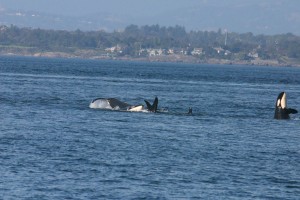
Wednesday was definitely one of the best days we have had with the whales so far. We followed 30 or 40 whales, which is almost half of the entire southern resident population, while they were resting, and when they woke up it was amazing. We witnessed close to 30 breaches, countless tail slaps, and the whales continued to “play†for over an hour. I will remember this day forever and we have some great pictures to help share the experience.
Read More
September 12th & 13th, 2010
After 3 weeks of intense studies on bioacoustics, the ecology and conservation of the southern resident killer whales of the Salish Sea and their prey of choice, Chinook salmon, among many other fascinating aspects of the San Juan ecosystem, the Beam Reach crew for this fall: Dr. Scott Veirs, Dr. Jason Wood, Dr. Val Veirs, Hana, Cat, Garrett, Dave, Meagan and myself, were ready to meet Captain Todd and his great Cat (short for catamaran) the “Gato Verde.”  The ship which will sail us through this great “blue orca domain†is really magnificent and upgraded as an eco-boat with a “silent†biodiesel engine and propellers that harvest energy as they spin. El “ Gato Verde”, a 42′ state of the art catamaran, was named by Captain Todd Shuster as a Spanish equivalent of “green cat”, green (verde) as the boat is run as an eco-ship and seeks sustainability in all aspects, and cat (gato) after the common abbreviation used for catamarans. And so, with a 23′ beam (boat width), a mast 63’ tall (off the water), a large fully-battened mainsail, a jib and a screecher (foremost sail), this great cat can top to speeds of 12 knots under sail (at 50% of wind speed) under ideal wind conditions, reaches 7.2 knots top speed under biodiesel-power and averages a cruising speed of 6.5 knots.
Our main work/research area will be the cockpit where all of our acoustic REC-equipment will be placed during the recordings. During this season will be using a total of 6 hydrophones: 4 on a linear array that trolls behind us attached to the cleat under the stern pulpit on the port side (aft-left), a High Frequency Hyd., also known as the CRT, trolling behind from the starboard pulpit. This arrangement will allow us to record the large range of the orca vocalizations, and, with detailed observations and meticulous data taking, will also let us localize the individual/s emitting the sounds.
The cabin or galley holds our kitchenette, dining and navigation tables (the latter known as the “nav tableâ€), this is indeed the most crowded area of the boat by far, as all of our meals and most of our meetings and clasess, as well as after-hours studying and data-entering takes place here. Our ‘dance’ as a group will be tested by our use of this space out of all other areas.
El gato has 4 cabins accessible from the cabin, 2 inside the starboard pontoon and two in the portside one. Each holds 2 people comfortably. Additionally, there  are two  single/occupancy cabins in triangular shape at the bow end of each pontoon, this are accessible through a hatches on the deck.
As sustainability is a very important component of our course, detailed energy and water consumption as well as “black water†production will be  monitored and recorded each morning. This allows the group and each student to be aware of their impact and ‘carbon footprint’ in a daily basis.
As far as active research on this first day, we learned the general protocol to deploy our hydrophone array and our CRT (high freq. hyd) to test and learn the basics. We also distributed the general daily duties among the crew for the first week.
After this brief description of what our “floating living quarters†for the next 5 weeks will be like, I shall move onto more picturesque accounts of our adventures and research in the Salish Sea.
Thanks for reading.
Fair winds to all.
V V
Read More
 This Sunday (10/10/10) Beam Reach will be joining thousands of other 350.org activists around the globe to do something about global warming. If you’d like to help reduce the concentration of carbon dioxide in the atmosphere from its current level, 390 parts per million (ppm), back down to what scientists say is a safe limit (350 ppm), then use this map to find a local event that interests you.
This Sunday (10/10/10) Beam Reach will be joining thousands of other 350.org activists around the globe to do something about global warming. If you’d like to help reduce the concentration of carbon dioxide in the atmosphere from its current level, 390 parts per million (ppm), back down to what scientists say is a safe limit (350 ppm), then use this map to find a local event that interests you.
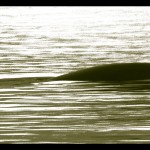
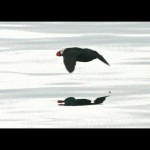
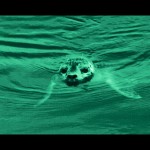
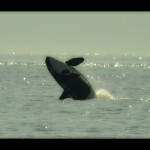
























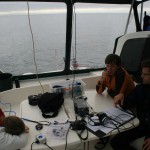
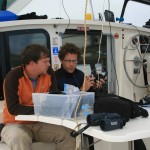
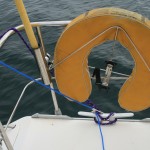
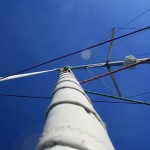
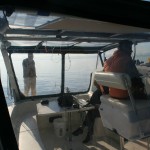
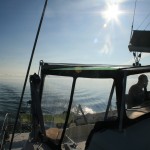
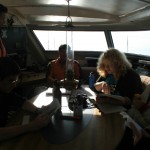
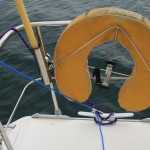
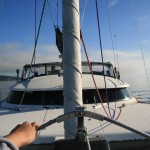
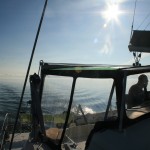
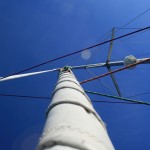


 Twitter
Twitter LinkedIn
LinkedIn Facebook
Facebook